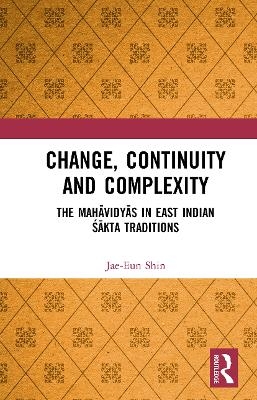
Change, Continuity and Complexity
The Mahāvidyās in East Indian Śākta Traditions
Seiten
2024
Routledge (Verlag)
978-1-032-65351-8 (ISBN)
Routledge (Verlag)
978-1-032-65351-8 (ISBN)
The Mahāvidyās are the representative Tantric feminine pantheon consisting of ten goddesses. It is formed by divergent religious strands & elements: the mātṛ & yoginī worship, the cult of Kālī, the Brahmanical strand of Puranic traditions, etc. This volume explores the historical process through which these traditions culminated in the M
The Mahāvidyās are the representative Tantric feminine pantheon consisting of ten goddesses. It is formed by divergent religious strands and elements: the mātṛ and yoginī worship, the cult of Kālī and Tripurasundarī, Vajrayāna Buddhism, Jain Vidyādevīs, Śaiva and Vaiṣṇava faith, Śrīvidyā, the Brahmanical strand of Puranic traditions, etc. This volume is the first attempt to explore the historical process, through which these traditions culminated in the Mahāvidyā cult and the goddesses with different origins and contradictory attributes were brought into a cluster, with special reference to socio-political changes in the lower Gaṅgā and Brahmaputra Valley between the 9th and 15th centuries CE.
Based on a close analysis of Purāṇas, Tantras and inscriptional evidence, and on extensive field research on archaeological remains as well as sacred sites, Jae-Eun Shin discusses the two trajectories of the Mahāvidyās in eastern Śākta traditions. Each led to the systematization of Daśamahāvidyās in a specific way: one, as ten manifestations of Durgā upholding dharma in the cosmic dimension, and the other, as ten mandalic goddesses bearing magical powers in the actual sacred site. Their attributes and characteristics have neither been static nor monolithic, and the mode of worship prescribed for them has changed in a dialectical religious process between Brahmanical and Tantric traditions of the region.
This is the definitive work for anyone seeking to understand goddess cults of South Asia in general and the history of eastern Śākta traditions in particular. To aid study, the volume includes images, diagrams and maps.
Please note: Taylor & Francis does not sell or distribute the Hardback in India, Pakistan, Nepal, Bhutan, Bangladesh and Sri Lanka.
The Mahāvidyās are the representative Tantric feminine pantheon consisting of ten goddesses. It is formed by divergent religious strands and elements: the mātṛ and yoginī worship, the cult of Kālī and Tripurasundarī, Vajrayāna Buddhism, Jain Vidyādevīs, Śaiva and Vaiṣṇava faith, Śrīvidyā, the Brahmanical strand of Puranic traditions, etc. This volume is the first attempt to explore the historical process, through which these traditions culminated in the Mahāvidyā cult and the goddesses with different origins and contradictory attributes were brought into a cluster, with special reference to socio-political changes in the lower Gaṅgā and Brahmaputra Valley between the 9th and 15th centuries CE.
Based on a close analysis of Purāṇas, Tantras and inscriptional evidence, and on extensive field research on archaeological remains as well as sacred sites, Jae-Eun Shin discusses the two trajectories of the Mahāvidyās in eastern Śākta traditions. Each led to the systematization of Daśamahāvidyās in a specific way: one, as ten manifestations of Durgā upholding dharma in the cosmic dimension, and the other, as ten mandalic goddesses bearing magical powers in the actual sacred site. Their attributes and characteristics have neither been static nor monolithic, and the mode of worship prescribed for them has changed in a dialectical religious process between Brahmanical and Tantric traditions of the region.
This is the definitive work for anyone seeking to understand goddess cults of South Asia in general and the history of eastern Śākta traditions in particular. To aid study, the volume includes images, diagrams and maps.
Please note: Taylor & Francis does not sell or distribute the Hardback in India, Pakistan, Nepal, Bhutan, Bangladesh and Sri Lanka.
Jae-Eun Shin is currently a research collaborator at Institute for Advanced Studies on Asia, University of Tokyo. She has written extensively on goddess cults and sacred sites in eastern India and on the history of Kāmarūpa, especially its state formation and religious identity construction.
1. Introduction 2. Grouping of Multiple Feminine Divinities 3. Making of the Mahāvidyās in the Śākta Upapurānas and Tantras in Eastern India 4. Locating of the Mahāvidyās in the Sacred Landscape 5. Conclusion
| Erscheinungsdatum | 22.08.2024 |
|---|---|
| Verlagsort | London |
| Sprache | englisch |
| Maße | 138 x 216 mm |
| Gewicht | 444 g |
| Themenwelt | Geisteswissenschaften ► Geschichte ► Regional- / Ländergeschichte |
| Geisteswissenschaften ► Religion / Theologie | |
| Naturwissenschaften ► Geowissenschaften ► Geografie / Kartografie | |
| Sozialwissenschaften ► Soziologie ► Spezielle Soziologien | |
| ISBN-10 | 1-032-65351-5 / 1032653515 |
| ISBN-13 | 978-1-032-65351-8 / 9781032653518 |
| Zustand | Neuware |
| Haben Sie eine Frage zum Produkt? |
Mehr entdecken
aus dem Bereich
aus dem Bereich
Erinnerungen
Buch | Softcover (2024)
Pantheon (Verlag)
CHF 22,40


